Condition-dependent effects of mating on longevity and fecundity of female Medflies: the interplay between nutrition and age of mating
- PMID: 23894611
- PMCID: PMC3722191
- DOI: 10.1371/journal.pone.0070181
Condition-dependent effects of mating on longevity and fecundity of female Medflies: the interplay between nutrition and age of mating
Abstract
Background: In various species mating exerts direct and indirect effects on female demographic traits ranging from life span shortening to behavioural shifts. A wealth of data regarding effects of nutrition on longevity and reproduction output also exists. Nonetheless, little is known regarding the interaction between the age of mating and nutrition on female fitness.
Methodology: We studied, the effects of protein deprivation and age of mating on female fitness traits, using a wild population of the Mediterranean fruit fly (medfly). We tested the hypotheses that (a) protein availability increases female lifespan and fecundity, (b) female longevity and egg production are independent of mating and the age of mating, and (c) female mating behaviour is independent of their age and nutritional status. Thus, we recorded the mating success and the copulation characteristics, as well as the egg production and survival of females mated at young or at old age and fed a full or a protein-deprived diet.
Results: Mating boosts egg production and reduces longevity of protein-fed females. On the contrary, mating increases the longevity of protein-deprived females. Mortality responses (negative or positive) to mating are expressed after a long lag phase. Old females are more receptive and less selective than young females regardless of the food regime.
Conclusions: Our findings suggest that condition (nutritional status and age) defines the positive or negative output of mating in female medflies. These results contribute towards understanding the effects of mating, aging, resource allocation and their interactions on survival and female reproduction.
Conflict of interest statement
Figures

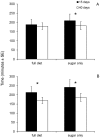

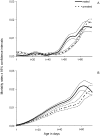
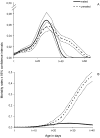
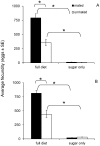
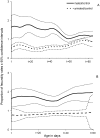

Similar articles
-
Relationship of age patterns of fecundity to mortality, longevity, and lifetime reproduction in a large cohort of Mediterranean fruit fly females.J Gerontol A Biol Sci Med Sci. 1998 Jul;53(4):B245-51. doi: 10.1093/gerona/53a.4.b245. J Gerontol A Biol Sci Med Sci. 1998. PMID: 18314553
-
Effects of early-life protein starvation on longevity and sexual performance of male medfly.PLoS One. 2019 Jul 25;14(7):e0219518. doi: 10.1371/journal.pone.0219518. eCollection 2019. PLoS One. 2019. PMID: 31344046 Free PMC article.
-
On the impact of re-mating and residual fertility on the Sterile Insect Technique efficacy: Case study with the medfly, Ceratitis capitata.PLoS Comput Biol. 2024 May 6;20(5):e1012052. doi: 10.1371/journal.pcbi.1012052. eCollection 2024 May. PLoS Comput Biol. 2024. PMID: 38709817 Free PMC article.
-
Interactions of mating, egg production and death rates in females of the Mediterranean fruit fly, Ceratitis capitata.Proc Biol Sci. 1998 Oct 7;265(1408):1879-94. doi: 10.1098/rspb.1998.0516. Proc Biol Sci. 1998. PMID: 9802244 Free PMC article. Review.
-
Biodemography of the Mediterranean fruit fly: aging, longevity and adaptation in the wild.Exp Gerontol. 2011 May;46(5):404-11. doi: 10.1016/j.exger.2010.09.009. Epub 2010 Oct 7. Exp Gerontol. 2011. PMID: 20933076 Free PMC article. Review.
Cited by
-
Age Related Assessment of Sugar and Protein Intake of Ceratitis capitata in ad libitum Conditions and Modeling Its Relation to Reproduction.Front Physiol. 2017 May 8;8:271. doi: 10.3389/fphys.2017.00271. eCollection 2017. Front Physiol. 2017. PMID: 28533753 Free PMC article.
-
A multicomponent screen for feeding behaviour and nutritional status in Drosophila to interrogate mammalian appetite-related genes.Mol Metab. 2021 Jan;43:101127. doi: 10.1016/j.molmet.2020.101127. Epub 2020 Nov 23. Mol Metab. 2021. PMID: 33242659 Free PMC article.
-
The Roles of Mating, Age, and Diet in Starvation Resistance in Bactrocera oleae (Olive Fruit Fly).Insects. 2023 Oct 29;14(11):841. doi: 10.3390/insects14110841. Insects. 2023. PMID: 37999040 Free PMC article.
-
Factors Influencing Copulation Duration in Dastarcus helophoroides (Fairmaire) (Coleoptera: Bothrideridae).Insects. 2024 Feb 2;15(2):104. doi: 10.3390/insects15020104. Insects. 2024. PMID: 38392523 Free PMC article.
-
Electronic recording of lifetime locomotory activity patterns of adult medflies.PLoS One. 2022 Jul 25;17(7):e0269940. doi: 10.1371/journal.pone.0269940. eCollection 2022. PLoS One. 2022. PMID: 35877614 Free PMC article.
References
-
- Chapman T, Liddle LF, Kalb JM, Wolfner MF, Partridge L (1995) Cost of mating in Drosophila melanogaster females is mediated by male accessory-gland products. Nature 373: 241–244. - PubMed
-
- Wigby S, Chapman T (2005) Sex peptide causes mating costs in female Drosophila melanogaster . Current Biology 15: 316–321. - PubMed
-
- Liedo P, De Leon E, Barrios MI, Valle-Mora JF, Ibarra G (2002) Effect of age on the mating propensity of the Mediterranean fruit fly (Diptera: Tephritidae). Florida Entomologist 85: 94–101.
Publication types
MeSH terms
Grants and funding
LinkOut - more resources
Full Text Sources
Other Literature Sources

